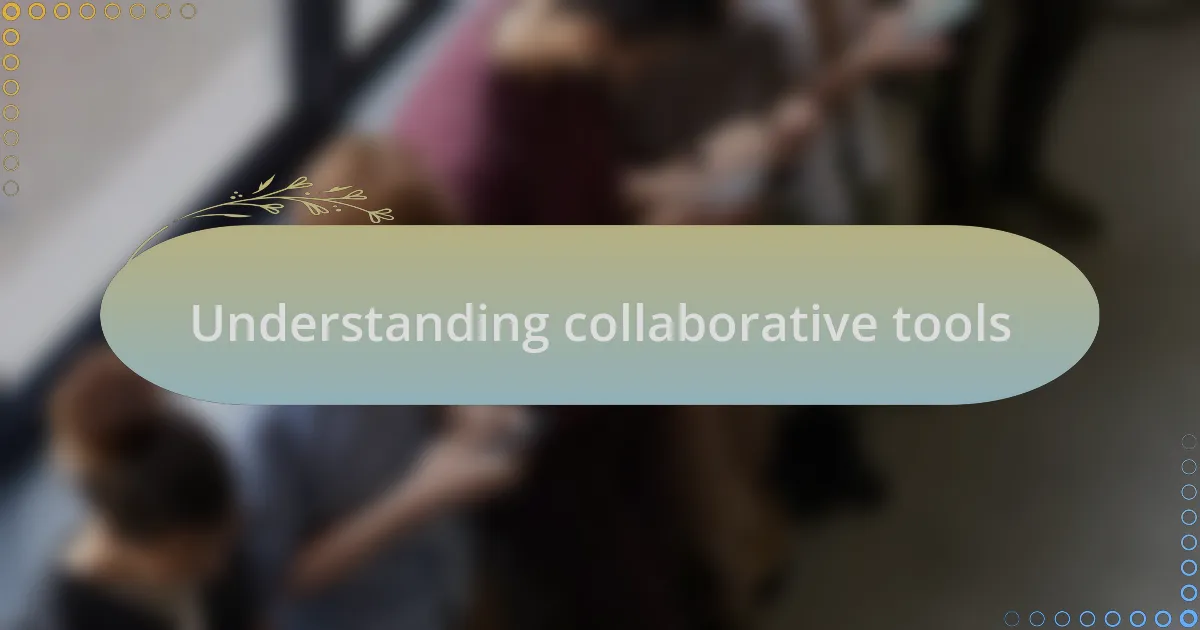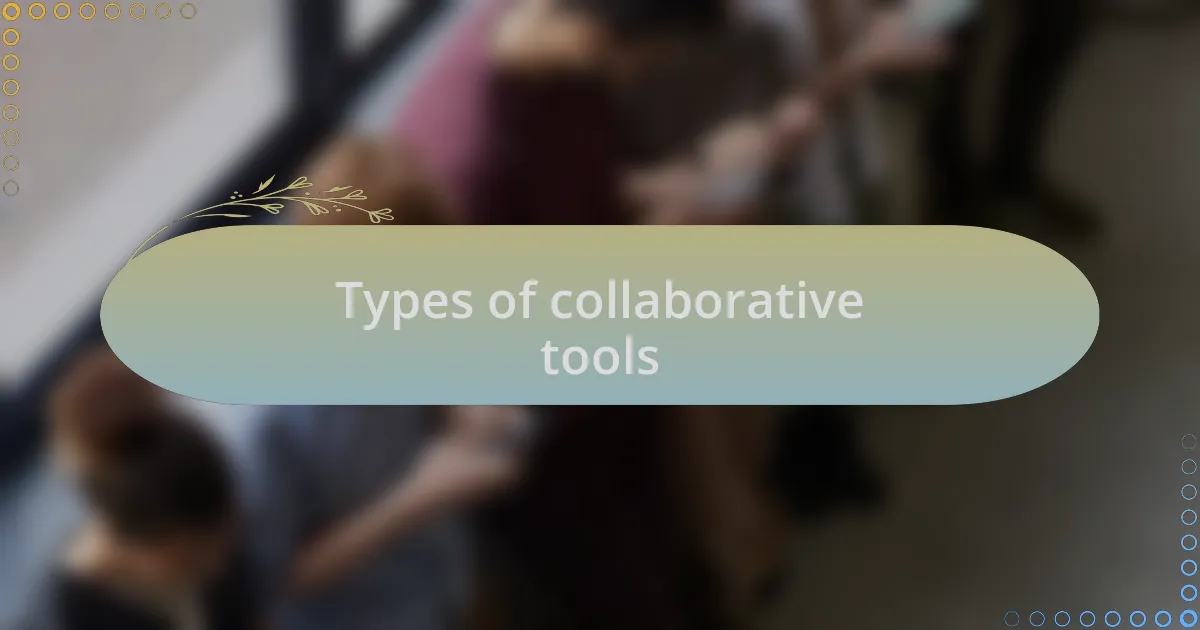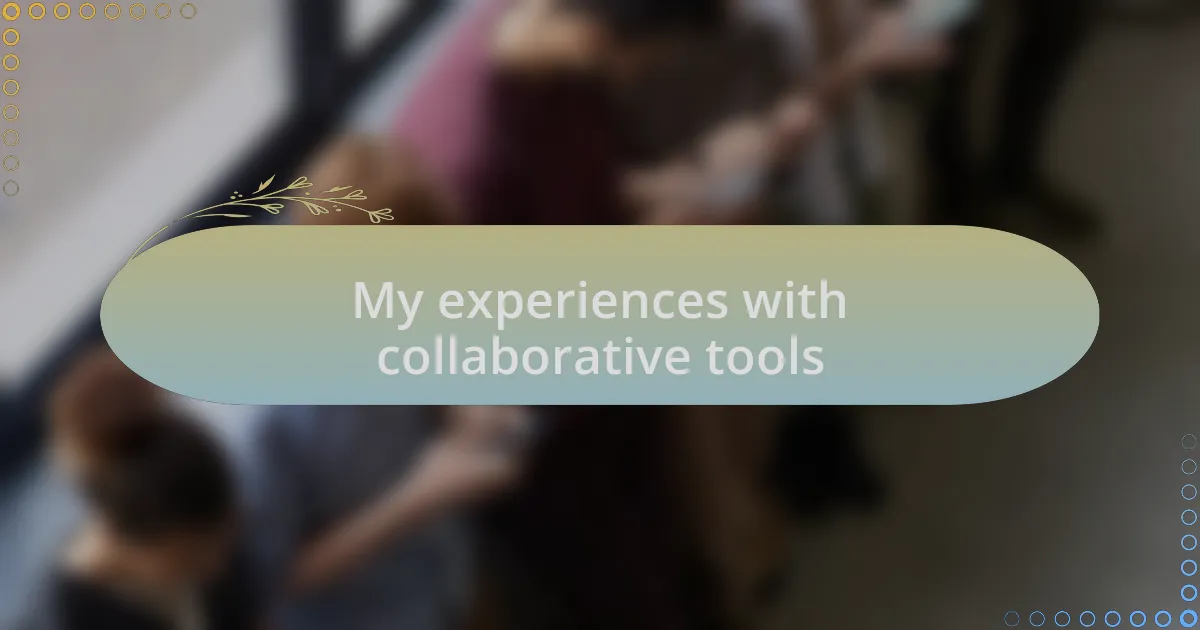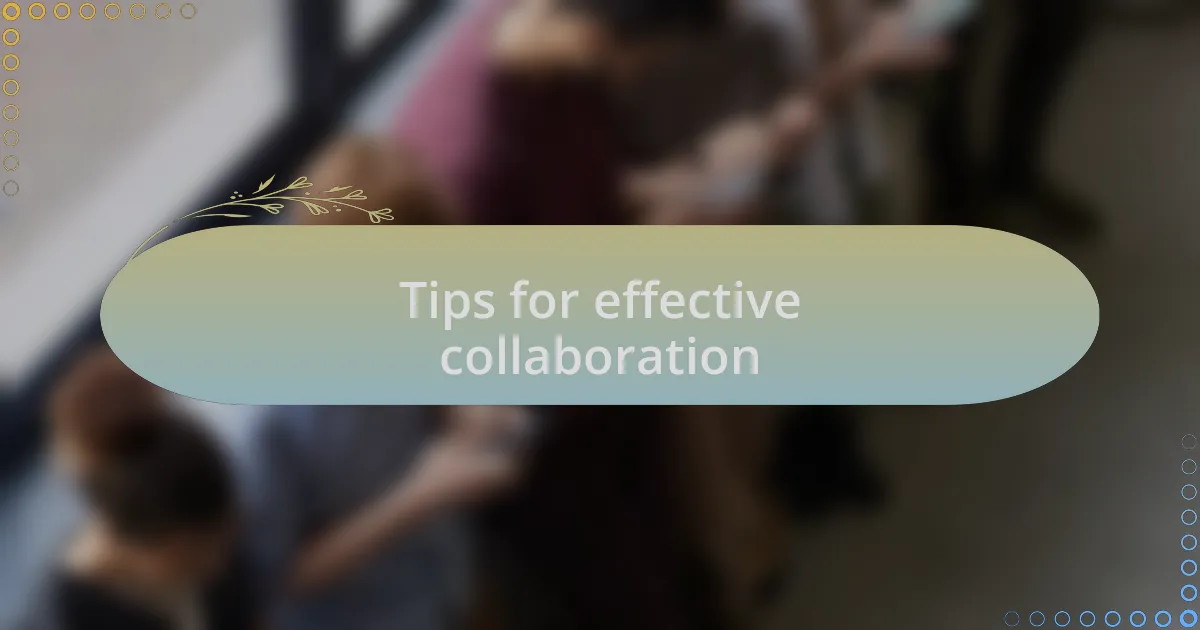Key takeaways:
- Collaborative tools streamline communication and task management, enhancing teamwork and networking opportunities.
- Building strong local business networks fosters collaboration, referrals, and mutual support, leading to unexpected growth opportunities.
- Diverse perspectives in collaborations enhance creativity and lead to innovative solutions, making inclusivity crucial.
- Regular check-ins and clear goal-setting improve accountability and team synergy during collaborative projects.

Understanding collaborative tools
Collaborative tools are essential for enhancing communication and teamwork, particularly in local business networking. I recall my first time using a project management tool with my colleagues. It transformed our chaotic email threads into organized task lists, allowing us to focus on what truly mattered: building connections and growing our businesses.
Have you ever felt overwhelmed by juggling multiple conversations across various platforms? Collaborative tools simplify this by providing a single space for conversation, file sharing, and project tracking. They really are a game changer when it comes to fostering relationships within a community.
The experience of using collaborative tools often feels like having a personal assistant who keeps everything in check. For instance, when I organized a local networking event, these tools helped me coordinate with vendors, speakers, and participants effortlessly. This not only saved time but also allowed me to maintain personal connections without the stress of managing endless details.

Importance of local business networking
Building a strong local business network is crucial because it opens doors to collaboration, referrals, and mutual support. I once connected with a local bakery owner at a networking event, and that simple conversation led to a collaboration that boosted both our sales. This experience taught me that relationships formed in the community can often provide unexpected opportunities that help all parties grow.
In my journey, I’ve found that local business networking isn’t just about making connections; it’s about fostering a sense of belonging. When I attend local meet-ups, I feel the energy and support of fellow entrepreneurs who understand the unique challenges we face. Have you ever felt more motivated after chatting with someone who shares your struggles? That shared understanding can fuel our passion and commitment to our businesses.
Moreover, local networking can significantly enhance a business’s visibility within the community. I remember hosting a small workshop and inviting fellow business owners to participate. The simple act of coming together not only increased our visibility but also fostered trust among attendees. It’s fascinating how collaboration can elevate not just individuals, but the entire local economy as well.

Types of collaborative tools
Collaborative tools come in various forms, each designed to facilitate teamwork and streamline communication. Project management software, for example, has transformed how my team and I tackle projects. I recall a time when we used a tool like Trello to visualize our tasks – it made organization a breeze and kept everyone accountable. Have you ever felt lost in project details? It can be overwhelming, but the right tool changes everything.
Another vital type of collaborative tool is communication platforms, such as Slack or Microsoft Teams. These tools allow for real-time chats and file sharing, which I find essential when coordinating with others remotely. I still remember the thrill of receiving immediate feedback on a marketing campaign via a quick message – that kind of instant interaction can energize a team like nothing else. It’s incredible how a simple message can spark new ideas.
Moreover, document collaboration tools like Google Docs stand out in fostering teamwork. They allow multiple users to edit and comment simultaneously, which I’ve found invaluable when brainstorming content. I once worked on a marketing strategy with a partner across town, and we’d swap insights live. It felt like we were in the same room, even though we weren’t. Can you imagine the creative possibilities that arise when ideas flow freely in real-time like that?

How collaborative tools enhance networking
Collaborative tools truly amplify networking by breaking down geographical barriers. I remember attending a virtual networking event, where meticulous use of breakout rooms allowed me to connect with entrepreneurs from around the globe. It was fascinating to share insights about local markets with someone half a world away, creating opportunities I never would have imagined.
Engagement is another key aspect enhanced by collaboration tools. For instance, I once participated in a group brainstorming session on a platform like Miro that involved participants from different regions. The energy was palpable as we contributed ideas in real-time—each ping of a new sticky note sent a wave of motivation around the group. How often do you leave networking events feeling uplifted by the shared knowledge and diverse perspectives?
Moreover, tracking collaborative efforts makes networking far more effective. Using project management tools, I’ve kept tabs on connections I’ve made, noting follow-ups and shared goals. This organization enables me to nurture those relationships actively. Have you ever thought about how easy it is to let valuable connections slip through the cracks without a system in place? Those little reminders and scheduled follow-ups can be game-changers in building lasting professional networks.

My experiences with collaborative tools
My experiences with collaborative tools have been largely transformative, enriching not only my professional life but also my creative processes. For example, I once facilitated a workshop using a shared Google Doc where participants could contribute ideas simultaneously. The experience was exhilarating; seeing thoughts evolve in real-time fostered a sense of camaraderie that transcended traditional networking norms. Can you imagine the impact of such a dynamic space on fostering creativity?
In another instance, I utilized Slack for a project with colleagues from various backgrounds, and I found it to be an incredible platform for feedback. The threaded conversations made it easy to track discussions without losing context, which is something I really appreciated. Each time someone chimed in with an insightful comment, it felt like we were building a mini-community right there inside our channels. Have you ever tapped into a resource that felt like it was custom-built for your team? It’s a remarkable feeling.
Reflecting on my journey, I’ve realized that the more I engage with these tools, the more I understand their potential for fostering authentic connections. One time, during a virtual lunch-and-learn session, I used Zoom breakout rooms to pair up participants for meaningful one-on-one discussions. The deep dives into each other’s experiences left many of us feeling inspired and more connected than I initially expected. It made me wonder: doesn’t the heart of networking lie in these genuine exchanges?

Tips for effective collaboration
Effective collaboration requires intentionality in communication, and I’ve found that setting clear goals at the outset significantly enhances outcomes. For instance, during a recent project, my team spent the first meeting defining what success looked like for us. This clarity not only aligned our efforts but also made it easier to address challenges as they arose. Have you set clear objectives with your collaborators to steer your work?
Another tip is to embrace diversity in your collaborations. I once participated in a brainstorming session where each member came from a different industry. The varied perspectives led to innovative solutions I never would have imagined alone. When we invite diverse viewpoints, it enriches our discussions and can lead to more creative outcomes. How do you ensure that your collaborations are inclusive of different ideas?
Lastly, don’t underestimate the power of regular check-ins. I learned this while using a project management tool that prompted daily updates. These touchpoints foster accountability and encourage team members to share progress or roadblocks. Have you considered how maintaining an open line of communication can elevate your team’s synergy? It truly can transform how you work together.